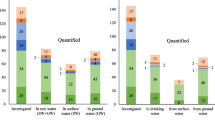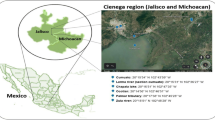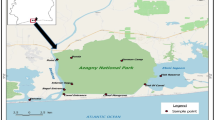Abstract
In this study, a multi-residue method was used to analyze 13 pesticides and 1 degradation product in surface and groundwater in the region with the largest sugar cane production in the world. The potential effects of individual pesticides and their mixtures, for aquatic life and human consumption, were evaluated. For the surface water, 2-hydroxy atrazine, diuron, carbendazim, tebuthiuron, and hexazinone were the most frequently detected (100, 94, 93, 92, and 91%, respectively). Imidacloprid (2579 ng L−1), carbendazim (1114 ng L−1), ametryn (1101 ng L−1), and tebuthiuron (1080 ng L−1) were found at the highest concentrations. For groundwater, tebuthiuron was the only quantified pesticide (107 ng L−1). Ametryn, atrazine, diuron, hexazinone, carbofuran, imidacloprid, malathion, carbendazim, and their mixtures presented risk for the aquatic life. No risk was observed for the pesticides analyzed in this work, alone or in their mixtures for human consumption.





Similar content being viewed by others
Explore related subjects
Discover the latest articles and news from researchers in related subjects, suggested using machine learning.Data availability
Most data generated or analyzed during this study are included in this published article and its supplementary information file.
References
Ackerman F (2007) The economics of atrazine. Int J Occup Environ Health 13:437–445. https://doi.org/10.1179/oeh.2007.13.4.437
Albuquerque AF, Ribeiro JS, Kummrow F, Nogueira AJA, Montagner CC, Umbuzeiro GA (2016) Pesticides in Brazilian freshwaters: a critical review. Environ Sci Process Impacts 00:1–9. https://doi.org/10.1039/C6EM00268D
ANA, CETESB (2011) National guide for collection and preservation of samples. National Water Agency /Environmental Company of São Paulo state, Brasília, DF (in Portuguese)
ANVISA (2020a) National Health Surveillance Agency–clomazone. http://portal.anvisa.gov.br/documents/111215/117782/C35%2B%2BClomazona.pdf/dc061ea2-0198-4437-b1e9-2d712e99024b. Accessed 16 June 2020
ANVISA (2020b) National Health Surveillance Agency-hexazinone. http://portal.anvisa.gov.br/documents/111215/117782/h02.pdf/ed5377aa-d856-435f-996e-c0b381170f60. Accessed 16 June 2020
ANVISA (2020c) National Health Surveillance Agency–imidacloprid. http://portal.anvisa.gov.br/documents/111215/117782/I13+%E2%80%93+Imidacloprido/9d08c7e5-8979-4ee9-b76c-1092899514d7. Accessed 16 June 2020
ANVISA (2020d) National Health Surveillance Agency–malathion. http://portal.anvisa.gov.br/documents/111215/117782/M01%2B%2BMalationa.pdf/abfcd7f8-da29-4c99-8586-054cbfbae2e9. Accessed 16 June 2020
ANVISA (2020e) National Health Surveillance Agency–azoxystrobin. http://portal.anvisa.gov.br/documents/111215/117782/A26%2B%2BAzoxistrobina.pdf/6b3c8202-7ef3-47be-8a04-5f60e380bbd1. Accessed 16 June 2020
Arias-Estévez M, López-Periago E, Martínez-Carballo E, Simal-Gándara J, Mejuto JC, García-Río L (2008) The mobility and degradation of pesticides in soils and the pollution of groundwater resources. Agric Ecosyst Environ 123:247–260. https://doi.org/10.1016/j.agee.2007.07.011
Beitz H (1994) Pesticides in ground and surface water. In: Intergovernmental Panel on Climate Change (ed) Chemistry of Plants Protection, Horst Börn. Cambridge University Press, Cambridge
Bortoluzzi EC, dos Rheinheimer DS, Gonçalves CS et al (2006) Contamination of surface water by pesticides as a function of soil use in the Agudo watershed, RS. Rev Bras Eng Agrícola e Ambient 10:881–887. https://doi.org/10.1590/s1415-43662006000400015 (in Portuguese)
Bro R, Smilde AK (2014) Principal component analysis. Anal Methods 6:2812–2831. https://doi.org/10.1039/c3ay41907j
Caldas SS, Bolzan CM, Guilherme JR, Silveira MAK, Escarrone ALV, Primel EG (2013) Determination of pharmaceuticals, personal care products, and pesticides in surface and treated waters: Method development and survey. Environ Sci Pollut Res 20:5855–5863. https://doi.org/10.1007/s11356-013-1650-9
Carabias-Martínez R, Rodríguez-Gonzalo E, Herrero-Hernández E et al (2002) Determination of herbicides and metabolites by solid-phase extraction and liquid chromatography-evaluation of pollution due to herbicides in surface and groundwaters. J Chromatogr A 950:157–166. https://doi.org/10.1016/S0021-9673(01)01613-2
Carazo-Rojas E, Pérez-Rojas G, Pérez-Villanueva M, Chinchilla-Soto C, Chin-Pampillo JS, Aguilar-Mora P, Alpízar-Marín M, Masís-Mora M, Rodríguez-Rodríguez CE, Vryzas Z (2018) Pesticide monitoring and ecotoxicological risk assessment in surface water bodies and sediments of a tropical agro-ecosystem. Environ Pollut 241:800–809. https://doi.org/10.1016/j.envpol.2018.06.020
Casara KP, Vecchiato AB, Lourencetti C, Pinto AA, Dores EFGC (2012) Environmental dynamics of pesticides in the drainage area of the São Lourenço River headwaters, Mato Grosso State, Brazil. J Braz Chem Soc 23:1719–1731. https://doi.org/10.1590/S0103-50532012005000037
Ccanccapa A, Masiá A, Navarro-Ortega A, Picó Y, Barceló D (2016) Pesticides in the Ebro River basin: occurrence and risk assessment. Environ Pollut 211:414–424. https://doi.org/10.1016/j.envpol.2015.12.059
CCME (1999) Canadian water quality guidelines for the protection of aquatic life: tebuthiuron. Canadian Council of Ministers of the Environment, Winnipeg
CCME (2001) Canadian Environmental Quality Guidelines: introduction. Canadian Council of Ministers of the Environment, Winnipeg
Chang MRC, Wu FT (2003) Diagenesis of sandstones of Piramboia Formation, East-Central São Paulo State. Geociencias 22:33–39 (in Portuguese)
de Armas ED, Monteiro RTR, Antunes PM et al (2007) Spatial-temporal diagnostic of herbicide occurrence in surface waters and sediments of corumbataí river and main affluents. Quim Nova 30:1119–1127. https://doi.org/10.1590/S0100-40422007000500013 (in Portuguese)
de Guida YS, Meire RO, Torres JPM, Malm O (2018) Air contamination by legacy and current-use pesticides in Brazilian mountains: an overview of national regulations by monitoring pollutant presence in pristine areas. Environ Pollut 242:19–30. https://doi.org/10.1016/j.envpol.2018.06.061
Diouf J (2007) Pesticide residues in food 2007 Joint FAO/WHO Meeting on Pesticide Residues. Communication Division, FAO
Diouf J (2008) The State of food and agriculture. Communication Division, FAO
Dores EFGC, Carbo L, Ribeiro ML, De-lamonica-freire EM (2008) Pesticide levels in ground and surface waters of Primavera do Leste Region, Mato Grosso. Brazil. 46:585–590
EC (1998) Council Directive 98/83/EC of 3 November 1998 on the quality of water intended for human consumption
Evans RM, Scholze M, Kortenkamp A (2015) Examining the feasibility of mixture risk assessment: a case study using a tiered approach with data of 67 pesticides from the Joint FAO/WHO Meeting on Pesticide Residues (JMPR). Food Chem Toxicol 84:260–269. https://doi.org/10.1016/j.fct.2015.08.015
FAO (2020) Food and Agriculture Organization of the United Nations. http://www.fao.org/faostat/en/#data/QC. Accessed 4 June 2020
Fernandes LA, Coimbra AM (2000) Stratigraphic review of the dastern portion of the bauru basin (Neocretaceous). Rev Bras Geociências 30:717–728 (in Portuguese)
Galaverna R, Ribessi RL, Rohwedder JJR, Pastre JC (2018) Coupling continuous flow microreactors to MicroNIR spectroscopy: ultracompact device for facile in-line reaction monitoring. Org Process Res Dev 22:780–788. https://doi.org/10.1021/acs.oprd.8b00060
Gawlik BM, Kettrup A, Muntau H (2000) Estimation of soil adsorption coefficients of organic compounds by HPLC screening using the second generation of the European reference soil set. Chemosphere 41:1337–1347. https://doi.org/10.1016/S0045-6535(00)00015-1
Gilio L, de Moraes MAFD (2016) Sugarcane industry’s socioeconomic impact in São Paulo, Brazil: a spatial dynamic panel approach. Energy Econ 58:27–37. https://doi.org/10.1016/j.eneco.2016.06.005
Gonzalez-Rey M, Tapie N, Le Menach K et al (2015) Occurrence of pharmaceutical compounds and pesticides in aquatic systems. Mar Pollut Bull 96:384–400. https://doi.org/10.1016/j.marpolbul.2015.04.029
Health Canada (2019) Guidelines for Canadian Drinking Water Quality—summary table. Water and Air Quality Bureau, Healthy Environments and Consumer Safety Branch, Health Canada, Ottawa, Ontario
Hoffman RS, Capel PD, Larson SJ (2000) Comparison of pesticides in eight U.S. urban streams. Environ Toxicol Chem 19:2249–2258. https://doi.org/10.1002/etc.5620190915
IBAMA (2020) Brazilian Institute of Environment and Renewable Natural Resources. Pesticide commercialization report. http://www.ibama.gov.br/agrotoxicos/relatorios-de-comercializacao-de-agrotoxicos#sobreosrelatorios. Accessed 20 January 2020 (in Portuguese)
INERIS (2020a) L’Institut national de l”environnement industriel et des risques–clomazone. https://substances.ineris.fr/fr/substance/614. Accessed 16 June 2020 (in French)
INERIS (2020b) L’Institut national de l”environnement industriel et des risques-carbofuran. https://substances.ineris.fr/fr/substance/605. Accessed 16 June 2020 (in French)
INERIS (2020c) L’Institut national de l”environnement industriel et des risques–malathion. https://substances.ineris.fr/fr/substance/1168. Accessed 16 June 2020 (in French)
INERIS (2020e) L’Institut national de l”environnement industriel et des risques–carbendazim. https://substances.ineris.fr/fr/substance/604. Accessed 16 June 2020 (in French)
Ippolito A, Fait G (2019) Pesticides in surface waters: from edge-of-field to Alessio Ippolito and Gabriella Fait. Curr Opin Environ Sustain 36:78–84. https://doi.org/10.1016/j.cosust.2018.10.023
Jacomini AE, De Camargo PB, Avelar WEP, Bonato PS (2011) Assessment of ametryn contamination in river water, river sediment, and mollusk bivalves in São Paulo State, Brazil. Arch Environ Contam Toxicol 60:452–461. https://doi.org/10.1007/s00244-010-9552-z
Kemmerich M, Bernardi G, Adaime MB, Zanella R, Prestes OD (2015) A simple and efficient method for imidazolinone herbicides determination in soil by ultra-high performance liquid chromatography-tandem mass spectrometry. J Chromatogr A 1412:82–89. https://doi.org/10.1016/j.chroma.2015.08.005
Kreuger J (1998) Pesticides in stream water within an agricultural catchment in southern Sweden, 1990-1996. Sci Total Environ 216:227–251. https://doi.org/10.1016/S0048-9697(98)00155-7
Lee HJ, Kim KY, Hamm SY, Kim MS, Kim HK, Oh JE (2019) Occurrence and distribution of pharmaceutical and personal care products, artificial sweeteners, and pesticides in groundwater from an agricultural area in Korea. Sci Total Environ 659:168–176. https://doi.org/10.1016/j.scitotenv.2018.12.258
Lerch RN, Donald WW, Li YX, Alberts EE (1995) Hydroxylated atrazine degradation products in a small missouri stream. Environ Sci Technol 29:2759–2768. https://doi.org/10.1021/es00011a010
Lerch RN, Blanchard PE, Thurman EM (1998) Contribution of hydroxylated atrazine degradation products to the total atrazine load in midwestern streams. Environ Sci Technol 32:40–48. https://doi.org/10.1021/es970447g
Liu Y, Liu S, Zhang Y, Qin D, Zheng Z, Zhu G, Lv Y, Liu Z, Dong Z, Liao X, Li X (2020) The degradation behaviour, residue distribution, and dietary risk assessment of malathion on vegetables and fruits in China by GC-FPD. Food Control 107:106754. https://doi.org/10.1016/j.foodcont.2019.106754
Lourenzani WL, Caldas MM (2014) Land use change from the sugar cane expansion in the western region of São Paulo state, Brazil. Ciência Rural 44:1980–1987. https://doi.org/10.1590/0103-8478cr20140186 (in Portuguese)
MAPA (2019) Ministry of Agriculture, Livestock and Supply – CONAB Monitoring of the Brazilian Harvest - Sugarcane, April, 2019 (in Portuguese)
MAPA (2020) Ministry of Agriculture, Livestock and Supply – AGROFIT Web on line. http://www.agricultura.gov.br/servicos-e-sistemas/sistemas/agrofit. Accessed 13 June 2020 (in Portuguese)
Meire RO, Khairy M, Targino AC, Galvão PMA, Torres JPM, Malm O, Lohmann R (2016) Use of passive samplers to detect organochlorine pesticides in air and water at wetland mountain region sites (S-SE Brazil). Chemosphere 144:2175–2182. https://doi.org/10.1016/j.chemosphere.2015.10.133
MMA (2005) Ministry of the Environment – CONAMA, Resolução Nr. 357, Brasília (in Portuguese)
Montagner CC, Vidal C, Acayaba RD, Jardim WF, Jardim ICSF, Umbuzeiro GA (2014) Trace analysis of pesticides and an assessment of their occurrence in surface and drinking waters from the State of São Paulo (Brazil). Anal Methods 6:6668–6677. https://doi.org/10.1039/c4ay00782d
Montiel-León JM, Munoz G, Vo Duy S, Do DT, Vaudreuil MA, Goeury K, Guillemette F, Amyot M, Sauvé S (2019) Widespread occurrence and spatial distribution of glyphosate, atrazine, and neonicotinoids pesticides in the St. Lawrence and tributary rivers. Environ Pollut 250:29–39. https://doi.org/10.1016/j.envpol.2019.03.125
Moschet C, Wittmer I, Simovic J, Junghans M, Piazzoli A, Singer H, Stamm C, Leu C, Hollender J (2014) How a complete pesticide screening changes the assessment of surface water quality. Environ Sci Technol 48:5423–5432. https://doi.org/10.1021/es500371t
MS (2017) Ministry of Health, Anexo XX da portaria de consolidação No 5, Brasília (in Portuguese)
Nascimento MM, da Rocha GO, de Andrade JB (2018a) A rapid low-consuming solvent extraction procedure for simultaneous determination of 34 multiclass pesticides associated to respirable atmospheric particulate matter (PM2.5) by GC–MS. Microchem J 139:424–436. https://doi.org/10.1016/j.microc.2018.03.023
Nascimento MM, Da Rocha GO, De Andrade JB (2018b) Pesticides in the atmospheric environment: an overview on their determination methodologies. Anal Methods 10:4484–4504. https://doi.org/10.1039/c8ay01327f
Nascimento RA, Nunoo DBO, Bizkarguenaga E, Schultes L, Zabaleta I, Benskin JP, Spanó S, Leonel J (2018c) Sulfluramid use in Brazilian agriculture: a source of per- and polyfluoroalkyl substances (PFASs) to the environment. Environ Pollut 242:1436–1443. https://doi.org/10.1016/j.envpol.2018.07.122
Nemeth-Konda L, Füleky G, Morovjan G, Csokan P (2002) Sorption behaviour of acetochlor, atrazine, carbendazim, diazinon, imidacloprid and isoproturon on Hungarian agricultural soil. Chemosphere 48:545–552. https://doi.org/10.1016/S0045-6535(02)00106-6
OECD/FAO (2019) OECD-FAO Agricultural Outlook 2019-2028. OECD Publishing, Paris/Food and Agriculture Organization of the United Nations, Rome
Oekotoxzentrum (2020) Proposals for Acute and Chronic Quality Standards. https://www.ecotoxcentre.ch/expert-service/quality-standards/proposals-for-acute-and-chronic-quality-standards/?_ga=2.140636084.762989616.1588776682-1699332275.1587582770. Accessed 16 June 2020
OJEU (2013) Official Journal of the European Union-DIRECTIVE 2013/39/EU OF THE EUROPEAN PARLIAMENT AND OF THE COUNCIL of 12 August 2013 amending Directives 2000/60/EC and 2008/105/EC as regards priority substances in the field of water
Peng Y, Fang W, Krauss M, Brack W, Wang Z, Li F, Zhang X (2018) Screening hundreds of emerging organic pollutants (EOPs) in surface water from the Yangtze River Delta (YRD): occurrence, distribution, ecological risk. Environ Pollut 241:484–493. https://doi.org/10.1016/j.envpol.2018.05.061
Pimentel D, Burgess M (2012) Small amounts of pesticides reaching target insects. Environ Dev Sustain 14:1–2. https://doi.org/10.1007/s10668-011-9325-5
Postigo C, López de Alda MJ, Barceló D, Ginebreda A, Garrido T, Fraile J (2010) Analysis and occurrence of selected medium to highly polar pesticides in groundwater of Catalonia (NE Spain): an approach based on on-line solid phase extraction-liquid chromatography-electrospray-tandem mass spectrometry detection. J Hydrol 383:83–92. https://doi.org/10.1016/j.jhydrol.2009.07.036
Proia L, Osorio V, Soley S, Köck-Schulmeyer M, Pérez S, Barceló D, Romaní AM, Sabater S (2013) Effects of pesticides and pharmaceuticals on biofilms in a highly impacted river. Environ Pollut 178:220–228. https://doi.org/10.1016/j.envpol.2013.02.022
Reilly TJ, Smalling KL, Orlando JL, Kuivila KM (2012) Occurrence of boscalid and other selected fungicides in surface water and groundwater in three targeted use areas in the United States. Chemosphere 89:228–234. https://doi.org/10.1016/j.chemosphere.2012.04.023
Rissato SR, Galhiane MS, Ximenes VF, de Andrade RMB, Talamoni JLB, Libânio M, de Almeida MV, Apon BM, Cavalari AA (2006) Organochlorine pesticides and polychlorinated biphenyls in soil and water samples in the Northeastern part of São Paulo State, Brazil. Chemosphere 65:1949–1958. https://doi.org/10.1016/j.chemosphere.2006.07.011
River S, Azevedo DDA, Gerchon E, Reis EO (2004) Monitoring of Pesticides and polycyclic aromatic hydrocarbons in water from. J Braz Chem Soc 15:292–299
Schulz R (2004) Field studies on exposure, effects, and risk mitigation of aquatic nonpoint-source insecticide pollution. J Environ Qual 33:419. https://doi.org/10.2134/jeq2004.0419
Silvério ACP, Machado SC, Azevedo L, Nogueira DA, de Castro Graciano MM, Simões JS, Viana ALM, Martins I (2017) Assessment of exposure to pesticides in rural workers in southern of Minas Gerais, Brazil. Environ Toxicol Pharmacol 55:99–106. https://doi.org/10.1016/j.etap.2017.08.013
Sodré FF, Locatelli MAF, Jardim WF (2010) An in-line clean system for the solid-phase extraction of emerging contaminants in natural waters. Quim Nova 33:216–219. https://doi.org/10.1590/S0100-40422010000100037 (in Portuguese)
Stehle S, Schulz R (2015) Agricultural insecticides threaten surface waters at the global scale. Proc Natl Acad Sci U S A 112:5750–5755. https://doi.org/10.1073/pnas.1500232112
Tominaga MY, Silva CR, Melo JP, Niwa NA, Plascak D, Souza CAM, Sato MIZ (2016) PCDD, PCDF, dl-PCB and organochlorine pesticides monitoring in São Paulo City using passive air sampler as part of the Global Monitoring Plan. Sci Total Environ 571:323–331. https://doi.org/10.1016/j.scitotenv.2016.07.173
Turgut C (2014) The contamination with organochlorine pesticides and heavy metals in surface water in Küçük Menderes River in Turkey, 2000-2002 The contamination with organochlorine pesticides and heavy metals in surface water in Ku c u. 29:2000–2002. 10.1016/S0160-4120(02)00127-7
U.S. EPA (1988) Integrated Risk Information System (IRIS) - Tebuthiuron. EPA CASRN 34014-18-1 U.S. Environmental Protection Agency, Washington, D.C
U.S. EPA (2005) Reregistration Eligibility Decision (RED) for Ametryn. EPA 738-R-05-006 U.S. Environmental Protection Agency, Washington, D.C
University of Hertfordshire (2020) The Pesticide Properties DataBase (PPDB) developed by Agriculture & Environment Research Unit (AERU), University of Hertfordshire, Hertfordshire, Hatfield
von der Ohe PC, Dulio V, Slobodnik J, de Deckere E, Kühne R, Ebert RU, Ginebreda A, de Cooman W, Schüürmann G, Brack W (2011) A new risk assessment approach for the prioritization of 500 classical and emerging organic microcontaminants as potential river basin specific pollutants under the European Water Framework Directive. Sci Total Environ 409:2064–2077. https://doi.org/10.1016/j.scitotenv.2011.01.054
WHO (2017) Guidelines for drinking-water quality: fourth edition incorporating the first addendum. Geneva: World Health Organization. Licence: CC BY-NC-SA 3.0 IGO
Wold S, Esbensen K, Geladi P (1987) Principal Component Analysis. Chemom Intell Lab Syst 2:37–52. https://doi.org/10.1016/0169-7439(87)80084-9
Xu F, Liang XM, Su F, Zhang Q, Lin BC, Wu WZ, Yediler A, Kettrup A (1999) A column method for determination of soil organic partition coefficients of eight pesticides. Chemosphere 39:787–794. https://doi.org/10.1016/S0045-6535(99)00014-4
Acknowledgments
The authors thank Paulo Stefano for technical assistance with Fig. 1 and the Environmental Company of São Paulo state (CETESB) for assistance with sampling.
Funding
This work was financed by the São Paulo State Research Support Foundation (FAPESP, Proc. No. 2015/18790-3 and Proc. No. 2014/24740-6). Raphael Acayaba acknowledges the Fund for Support to Teaching, Research and Outreach Activities (FAEPEX) in the form of fellowship.
Author information
Authors and Affiliations
Contributions
RA, GU, and CM contributed to the study conception and design. Material preparation, data collection, and analysis were performed by RA, AA, and RR. All samples were analyzed by RR. The first draft of the manuscript was written by RA, AA, GU, and CM and all authors commented on previous versions of the manuscript. All authors read and approved the final manuscript.
Corresponding author
Ethics declarations
Conflict of interest
The authors declare that they have no conflict of interest.
Ethics approval and consent to participate
Not applicable
Consent for publication
Not applicable
Additional information
Responsible Editor: Ester Heath
Publisher’s note
Springer Nature remains neutral with regard to jurisdictional claims in published maps and institutional affiliations.
Supplementary information
ESM 1
(DOCX 896 kb)
Rights and permissions
About this article
Cite this article
Acayaba, R.D., de Albuquerque, A.F., Ribessi, R.L. et al. Occurrence of pesticides in waters from the largest sugar cane plantation region in the world. Environ Sci Pollut Res 28, 9824–9835 (2021). https://doi.org/10.1007/s11356-020-11428-1
Received:
Accepted:
Published:
Issue Date:
DOI: https://doi.org/10.1007/s11356-020-11428-1




